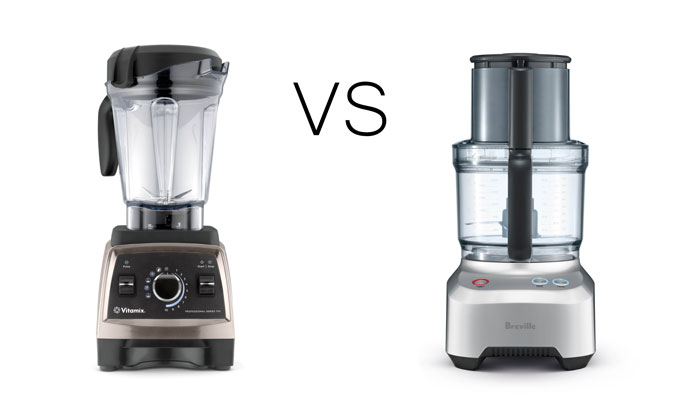Are you confused about buying a food processor or a blender for your kitchen? Both appliances have unique features and benefits, but which one best fits your cooking needs?
In this post, our expert will comprehensively compare food processors and blenders, including their functionalities, pros and cons, and recommended uses.
You’ll also get some essential tips on choosing the right appliance based on your cooking preferences and budget.
Whether you’re a beginner cook or a seasoned pro, this article will help you make an informed decision and take your culinary skills to the next level.
Don’t miss it!
Food processors and blenders are similar in theory. Either one is a container with a blade inside, topped with a lid, sitting on a stand with a motor to power it. But that is as far as it goes for similarities.
Blenders and food processors are two common kitchen appliances often used for similar purposes, but they do have some differences in design, function, and the types of foods they can handle.
Main Differences Between Blenders and Food Processors:
Design: Blenders typically have a tall, narrow container with a blade at the bottom that spins rapidly to blend the ingredients together. Food processors have wider, shorter bowls with a variety of blades and disks that can be changed to perform different functions.
Function: Blenders are primarily used for making smoothies, purees, and soups, and they can also crush ice and make frozen drinks. Food processors are better for chopping, slicing, shredding, grating ingredients, and making dough, nut butter, and dips.
Blades: Blenders usually have only one type of blade that can only perform one function, which is blending. Food processors have multiple blades and disks that can be interchanged depending on the task at hand, such as chopping, slicing, or shredding.
Texture: Blenders are great for creating smooth, uniform textures, such as purees and smoothies. Food processors can produce coarser, uneven textures, such as chopped vegetables or grated cheese.
Capacity: Blenders are typically designed for smaller batches and are ideal for single servings or small families. Food processors are larger and can handle larger quantities of food, making them a good choice for meal prep or cooking for larger groups.
In summary, blenders are best suited for liquid-based foods that need to be pureed or blended, while food processors are better for preparing solid foods that need to be chopped, sliced, or grated.
When To Use a Food Processor Or a Blender?
- A blender has a jar with blades on the bottom that cut food into small particles and whirl them around. That’s why the blender purees and liquifies so well. This makes it better for recipes where smooth, even consistency is key. Blenders also crush ice, so they’re the best for frozen drinks. Overall, the blender works best when liquid is involved; it can also whip cream for dessert or eggs for a fluffy omelet.
- A food processor is more of an all-around kitchen workhorse. It is like a sous-chef that preps all the ingredients tedious work for the chef. Switching blades and discs and using different speeds — plus the pulse function — gives the cook more control. The food processor has a wide work bowl with an S-shaped blade in the bottom. It works well on dry ingredients, such as chopping herbs, pulverizing graham crackers for pie crust, or kneading dough. It can make short work of a block of mozzarella for pizza or shred carrots for a cake in seconds.
Physical Differences Between Blenders and Food Processors
Blenders and food processors have some distinct physical differences that set them apart from each other:
Shape and Size: Blenders typically have a tall and narrow shape, while food processors have a wider and shorter shape. Blenders usually have a capacity of around 1 to 2 liters, while food processors can have a capacity of up to 12 cups.
Blades: Blenders usually have a single blade at the bottom that spins rapidly to blend the ingredients together. Food processors, on the other hand, have a variety of interchangeable blades and disks that can perform different functions, such as chopping, slicing, shredding, and grating.
Control Options: Blenders typically have a few speed settings and a pulse function, while food processors may have more speed and pulse options. Some food processors also have different settings for different functions, such as chopping, shredding, and mixing.
Lid: Blenders typically have a removable lid with a central opening for adding ingredients during blending. Food processors usually have a wider and latched lid with a feed chute that allows ingredients to be added while the machine is running.
Weight: Food processors are usually heavier than blenders due to their larger size and more powerful motor.
Function: While blenders are primarily used for blending and pureeing, food processors are more versatile and can perform a wider range of functions, such as chopping, shredding, slicing, grating, and mixing dough.
These physical differences between blenders and food processors determine which appliance is better suited for certain tasks in the kitchen. Ultimately, the choice between a blender and a food processor depends on your needs and the recipes you plan to make.
Which is Better: A Food Processor or A Blender?
Whether a food processor or a blender is better depends on what you want to use it for.
Blenders are best for pureeing, liquefying, and blending ingredients. They are ideal for making smoothies, milkshakes, soups, sauces, and dips. Blenders are also great for crushing ice and making frozen drinks.
On the other hand, food processors are best for chopping, slicing, grating, and shredding ingredients. They are ideal for making things like pesto, hummus, nut butter, and dough. Food processors are also great for preparing ingredients for dishes like salads and casseroles.
If you have to choose between a blender and a food processor, consider what you plan to use it for the most. Are you making a lot of smoothies or purees? Then a blender would be a better choice. Do you do a lot of chopping and shredding for recipes? Then a food processor is the way to go.
However, it is worth noting that both appliances can be very useful in the kitchen, and many people choose to have both. By having both a blender and a food processor, you can take advantage of their unique functions and use them to make a wider range of recipes.
Which Recipes Work Better on Blenders, and Which Work Better on Food Processors?
Blenders and food processors have different functions, making them better suited for certain recipes. Here are some examples of recipes that work better in a blender versus a food processor and vice versa:
Recipes That Work Better in a Blender:
- Smoothies and milkshakes: Blenders are great for making smoothies and milkshakes because they can quickly and easily blend fruits, vegetables, and other ingredients into a smooth and creamy drink.
- Purees and sauces: Blenders are also great for making purees and sauces, such as tomato sauce, hummus, or pesto. The high-speed blades of a blender can easily puree and blend ingredients into a smooth consistency.
- Soups: Blenders can also be used to puree hot soups and make them smoother and creamier.
Recipes That Work Better in a Food Processor:
- Dough: Food processors are great for making dough for bread, pizza, and pasta. The blades of a food processor can easily mix and knead the dough, making it easy to prepare homemade dough from scratch.
- Chopped vegetables: Food processors are also great for chopping vegetables, such as onions, garlic, carrots, and celery. They can quickly and easily chop ingredients into small, uniform pieces.
- Grated cheese: Food processors can also be used to grate cheese, which can save a lot of time and effort compared to grating cheese by hand.
- Baby Food is a task for a good processor. Pureé fruits and vegetables in large batches to fit the work bowl, or use a smaller bowl if your food processor has one.
Bottom line:
Generally, if you’re preparing something that needs to be blended into a smooth consistency, like a smoothie or sauce, then a blender is likely the better option. However, if you need to chop, shred, or knead ingredients, then a food processor is likely the better choice.
Think of a food processor as a kitchen assistant — chopping, pureeing, making pastry dough, slicing, shredding, and even dicing. Meanwhile, a blender is meant primarily for smoothies and drinks.
You Might Also Like
Food Processor Or Blender - Which You Should Buy!
Food processors and blenders are similar in theory. So, when should you use a food processor or a blender? We'll go over it all ...


![7 Best Smoothie Blenders [2022]](https://m.media-amazon.com/images/I/31QcKPzaAXL._SL500_.jpg)
